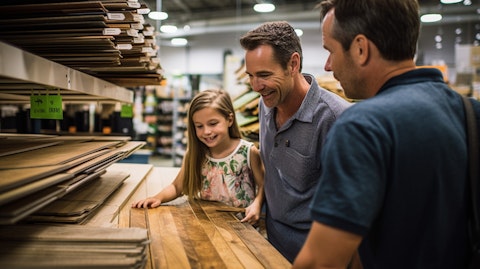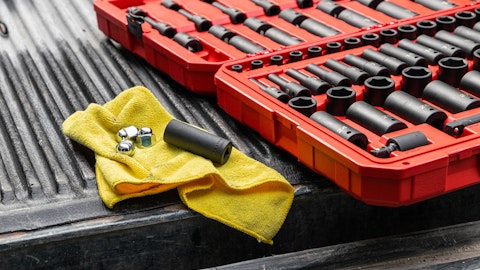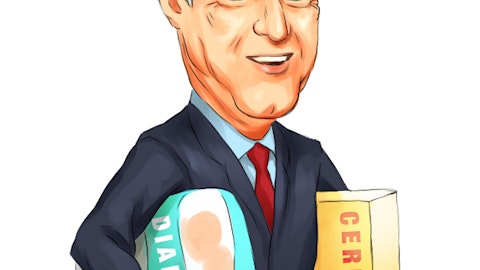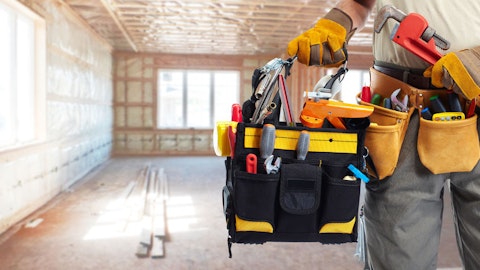Griffon Corporation (NYSE:GFF) Q4 2023 Earnings Call Transcript November 15, 2023
Operator: Greetings, and welcome to the Griffon Corporation Fiscal Fourth Quarter 2023 Earnings Conference Call. [Operator Instructions] As a reminder, this conference is being recorded. It is now my pleasure to introduce your host, Brian Harris, Chief Financial Officer. Thank you. Mr. Harris, you may begin.
Brian Harris: Thank you. Good morning. It’s my pleasure to welcome everybody to Griffon’s fourth quarter and fiscal 2023 earnings call. Joining me for this morning’s call is Ron Kramer, Griffon’s Chairman and Chief Executive Officer. Our press release was issued earlier this morning and is available on our website at www.griffon.com. Today’s call is being recorded, and the replay instructions are included in our earnings release. Our comments will include forward-looking statements about Griffon’s performance. These statements are subject to risks and uncertainties that can change as the world changes. Please see the cautionary statements in today’s press release and in our SEC filings. Finally, some of today’s remarks, we’ll adjust for items that affect comparability between periods. These items are explained in our non-GAAP reconciliations included in our press release. With that, I’ll turn the call over to Ron.
Ron Kramer: Good morning, everyone. Thank you for joining us. We’re pleased with our results for the fourth quarter and the fiscal year. The record performance of our Home and Building Products, HBP segment drove our results as Clopay and CornellCookson continue to deliver strong free cash flow and operating margins. Our Consumer and Professional Products or CPP segment improved in the fourth quarter, and we’re optimistic about its repositioning for the future. For the year, HBP revenue increased 5% to $1.6 billion, driven by continued growth in commercial volume. As expected, residential volume decreased as backlog levels normalized. HBP had favorable price and mix across all products and channels. HBP’s fourth quarter performance benefited from increased investment in marketing and sales for both residential and commercial channels, following two years of reduced activity due to elevated backlog and extended lead times.
HBP also continue to invest in productivity and innovation to further drive growth, including expanding Clopay’s Troy, Ohio sectional door manufacturing capacity and adding advanced manufacturing equipment to better satisfy customer demand for premium products. Turning to Consumer and Professional Products segment, CPP’s results for the year continue to reflect challenging market conditions with revenue decreasing 18% to $1.1 billion. All channels and geographies were affected by reduced consumer demand and elevated customer inventory levels. As we announced previously to address the impact of these market conditions on certain U.S. product lines, CPP is expanding its global sourcing strategy. By utilizing an asset-light structure, CPP’s U.S. operations would be better position to serve customers with a more flexible and cost-effective global sourcing model.
The global sourcing expansion project remains on schedule and within budget. By the end of December 2023, operations at two manufacturing facilities and four wood mills will representing over 1 million square feet of space will cease. The remaining affected AMES locations will be transitioned during calendar year 2024. The global sourcing expansion at AMES is a key element of our strategy to improve the margins of the CPP segment, and we are pleased by the progress made so far. We will continue to provide updates throughout the year as we achieve additional milestones in the process. Turning to capital allocation. In fiscal 2023, we took significant actions to deliver shareholder value and strengthen our balance sheet through cash dividends, stock buybacks and debt repayment.
In May, we increased our regular quarterly dividend by 25% to $0.125 per share, paid a $2 per share special dividend, and announced a $200 million increase to our share repurchase authorization, bringing the total then to $258 million. At the end of fiscal year September 30, we’ve repurchased more than 4.1 million shares for $151 million. In total, during fiscal ’23, we returned $285 million to shareholder dividends through dividend payment and share repurchases. It’s also important to note we’re able to deliver this value while maintaining our leverage at 2.6x. Since September 30, we purchased an additional 1.1 million shares. And this morning, the Griffon Board announced the $200 million increase to its share repurchase authorization, bringing the current authorization to a total of $262 million.
Since April, Griffon has repurchased 5.3 million shares for a total of $196 million or $37.15 per share through yesterday, November 14, 2023. These share repurchases represent 9.2% of the shares outstanding as of March 31, 2023. During fiscal ’23, we also took action to improve our financial flexibility and strengthen our balance sheet. We increased the size of our revolving credit facility from $400 million to $500 million and extended the maturity of the revolver to August 1, 2028. Also in the fourth quarter, we repaid $25 million of our Term Loan B facility. In fiscal ’24, we will continue to use our free cash flow to support our capital allocation strategy with a focus on opportunistically repurchasing shares, reducing debt and supporting our regular quarterly dividend.
Also this morning, the Griffon Board authorized a regular quarterly dividend of $0.15 per share payable on December 14 to shareholders of record on November 28, marking the 49th consecutive quarterly dividend to shareholders. This is a 20% increase over our last quarterly dividend and a 50% increase compared to our November 2022 dividend. Our dividend has grown at an annualized compound rate of 18% since we initiated dividends in 2012. These actions reflect the strength of our business as well as our confidence in our strategic plan and our outlook. I’ll turn it back to Brian for the financial update and to provide details about our 2024 guidance.
Brian Harris: Thank you, Ron. I’ll start with our fourth quarter performance, and then review our guidance for fiscal ’24. Fourth quarter revenue was of $641 million decreased by 10%, and adjusted EBITDA before unallocated amount of $135 million decreased by 3%, both in comparison to the prior year. The related EBITDA margin was 21%, an increase of 140 basis points over the prior year fourth quarter. Gross profit on a GAAP basis for the quarter was $246 million compared to $250 million in the prior year quarter. Excluding items that affect comparator from the current and prior year period, gross profit was $250 million in the current quarter compared to $253 million in the prior year. Normalized gross margin increased year-over-year by 360 basis points to 39.2%.

Fourth quarter GAAP selling, general and administrative expenses were $157 million compared to $166 million in the prior year quarter. Excluding adjusting items from both periods, SG&A expenses were $146 million or 22.8% of revenue compared to the prior year of $148 million or 20.8% of revenue. Fourth quarter GAAP income from continuing operations was $42 million or $0.79 per share compared to the prior year loss of $415 million, which was driven by CPP impairment charges. Excluding all items that affect comparability from both periods, current quarter adjusted net income from continuing operations was $63 million or $1.19 per share compared to the prior year of $60 million or $1.09 per share. Corporate unallocated expenses, excluding depreciation, were $13.5 million in the quarter compared to $14.2 million in the prior year.
Net capital expenditures were $34 million in the fourth quarter compared to $9 million in the prior year quarter. The increase was primarily driven by a net $20 million related to the acquisition of the HBP headquarters facility in Mason, Ohio, and the manufacturing facility for ClosetMaid in Ocala, Florida, as we capitalized on the opportunity to acquire these critical facilities below market value. Depreciation and amortization totaled $15.4 million for the fourth quarter compared to $17.6 million in the prior year. Regarding our segment performance. Revenue for Home and Building Products decreased 7% over the prior year quarter, driven by residential volume, partially offset by increased commercial volume. Adjusted EBITDA decreased 9% compared to the prior year quarter, driven by the decreased revenue, coupled with increased labor, marketing and advertising, partially offset by reduced material costs.
Consumer and Professional Products revenue decreased 13% from the quarter to $247 million. The reduction in revenue was primarily attributable to reduced volume across all channels and geographies driven by soft consumer demand, elevated customer inventory levels and customer supplier diversification in U.S. CPP adjusted EBITDA increased $14 million from the prior year $7 million, driven by reduced material costs, partially offset by the impact of reduced revenue noted above. In May, we announced that CPP is expanding its global sourcing strategy for products manufactured and sold in the U.S. to address evolving market conditions. Utilizing an asset-light model enables CPP to continue providing high-quality products, strengthen its competitive position and leverage industry-leading service and distribution that our customers and consumers expect.
Further, these actions position CPP to achieve target EBITDA margins of 15% and generate substantial additional value for our shareholders. The product remains on time and on budget with completion expected by the end of calendar 2024. In the quarter ended September 30, CPP incurred pretax cash charges of $10 million related to the expansion of its global sourcing strategy. Regarding our balance sheet and liquidity, as of September 30, 2023, we had net debt of $1.4 billion and net debt-to-EBITDA leverage of 2.6x as calculated based on our debt covenants. We remained net debt and leverage neutral with the prior quarter ending June ’23, even after returning approximately $72 million to shareholders via stock buybacks and dividends in the quarter.
The prior year-end net debt was $1.5 billion and leverage was 2.9x. Regarding our 2024 guidance, we expect revenue of $2.6 billion and segment adjusted EBITDA of $525 million for fiscal 2024, which excludes unallocated costs of $54 million, charges related to the AMES global sourcing expansion for approximately $25 million, and strategic review retention expenses of approximately $10 million. We anticipate ’24 HBP revenue will decrease 3% to 5% year-over-year due to the first half of ’24 being compared to the prior year, which included volume from significant residential door backlog and the return to normal seasonal demand patterns, which historically has less demand in our second quarter ended March. These factors will be partially offset by market share gains in both residential and commercial.
HBP EBITDA margin for 2024 is expected to remain in excess of 30%. The phasing of EBITDA performance will follow the same general trends as discussed with revenue, with an unfavorable comparison to the prior year and the first half followed by a stronger second half. With respect to CPP, we expect 2024 revenue to decrease 3% to 5% year-over-year due to continued soft demand and high customer inventory levels partially offset by normalized weather. The first half is expected to compare unfavorably year-over-year as customer destocking continues with gradual improvement during the second half as inventory levels return to normal. CPP EBITDA margin is expected to see modest improvement year-over-year, particularly in the second half as the AMES U.S. operations transition to an asset-light operating model.
Total capital expenditures for fiscal year ’24 are expected to be $70 million. This amount includes the capital required to complete the 100,000 square foot expansion and upgrades at Clopay sectional door manufacturing facility in Troy, Ohio. Depreciation and amortization is expected to be a total of $63 million of which $22 million is amortization. We expect to generate free cash flow for the full year in excess of net income, inclusive of the capital investments. As we have seen historically, we expect a seasonal pattern with cash usage in the first half followed by a strong second half cash generation. This includes the impact of cash outflows related to the global sourcing initiative. We expect interest expense of approximately $103 million in fiscal ’24.
Our expected normalized tax rate will be approximately 28%. As is always the case, geographic earnings mix and any legislative action, including new guidance on tax reform matters may impact rates. Now I’ll turn over the call back over to Ron.
Ron Kramer: Thanks, Brian. We enter 2024 with a proven strategy, skilled team and strong balance sheet, positioning us for future growth while remaining flexible in an uncertain macroeconomic environment. Before we turn to questions, I want to acknowledge and thank the employees and management teams of our businesses. It’s because of their dedication and effort that Griffon continues to see such strong operating performance. We’ll continue to use the strong operating performance and free cash flow from our business to drive our capital allocation strategy to deliver long-term value for our shareholders. This strategy will continue to include investing in our businesses, opportunistically, we repurchasing shares and reducing debt. These actions underscore the confidence of Griffon’s Board and management in our outlook and strategic plan. Operator, we’re happy to take any questions.
See also 20 Countries with Most Prostitutes in the World and 15 Countries With Most Unfaithful Husbands In The World.
Q&A Session
Follow Griffon Corp (NYSE:GFF)
Follow Griffon Corp (NYSE:GFF)
Operator: [Operator Instructions] Our first question comes from Joe Ahlersmeyer from Deutsche Bank. Please proceed.
Joe Ahlersmeyer: Hi, everybody. Good morning, and thanks for taking the question.
Brian Harris: Good morning.
Joe Ahlersmeyer: And congrats on the results and the favorable outlook. I certainly appreciate also the detail around the cash flow. Maybe just to start on the HBP business. Regarding the outlook, I think it makes sense. A lot of it depends or hinging on sort of the comparison versus the first half of prior year. But I was wondering if you could just talk about sequentially what you’re seeing between your two kind of residential and commercial businesses within there? Just sequentially, what’s the momentum in the business looks like?
Brian Harris: Sue. We continue to see reduced residential volume, though we expect some market share gains in ’24. On the commercial side, we had volume benefits, increased volume in 2023, and we expect 2024 to continue that trend. We continue to have good order volume in that area.
Joe Ahlersmeyer: Sounds good. And then just thinking about the margin guidance in excess of 30%. Certainly, that’s above the long-term guide. Wondering if there’s something to kind of call out there to bridge between that and the guidance, but also if you’re willing to sort of put an upper bound on that guidance rather than just 30% plus.
Brian Harris: Sure. So we do have long-term expectations out there of 25% to 28%, even though HBP continues to operate at 30% plus, and we expect it – we were seeing nothing that is going to change that. We have that guidance out there, perhaps a little conservatism and also considering downturns in the market, and that’s what we think is the bottom for our business, those types of margins.
Ron Kramer: But 2024, we’re off to an excellent start, and we see the 30% being well within our capabilities. and sustainability. So the business has proven itself to be resilient, the positioning that has happened over a period of years of expanding the residential business, the development of our commercial business. We have an excellent team doing the best in this industry, and we continue to be the leader, and we expect to both grow the business, take market share and maintain our margins for ’24.
Operator: Our next question comes from Bob Labick with CJS Securities. Please proceed.
Bob Labick: Good morning, and congratulations on a great quarter and a really great fiscal year as well.
Brian Harris: Thanks Bob. Good morning.
Bob Labick: Yes. So I wanted to start – I’m just sticking with HBP because it’s obviously doing so well. It’s been operating at full tilt. You’ve gotten a lot of stuff out of backlog. And then you just talked a little bit about adding capacity. So maybe my question was going to be before you mentioned Troy, where do you stand in terms of your capacity and where is it going? And then you mentioned the expansion at Troy. So maybe you could elaborate on the expansion of Troy? What you’re using it for and how it will change your throughput and your opportunity? How much you can grow revenue from this, et cetera, et cetera, please?
Brian Harris: Sure. So the project in Troy is to expand capacity for the higher end of the products that we make and to make sure we can continue to get that in the marketplace. It also gives us a chance to make sure we have equipment operational in the future and spread out so we can maintain older equipment and get away from running the plants 24/7. It gives us a much more normalized cadence to ensure that we can properly maintain equipment, avoids late shifts and weekend shifts and continues to keep us in a position where we can grow our share.
Bob Labick: Okay. That sounds great. And I guess just for my follow-up, you started to answer this on the last question as well. But could you elaborate on the structural changes at HBP that have enabled you to drive margins so high and up to this strong and now obviously impressive and sustainable level. Just give us kind of just elaborate on the changes from then till now and why we obviously have a strong vision for revenues and margins going forward?
Ron Kramer: So let’s start with this is 15 years in the making. So go back to 2008 in the global financial crisis. In 2009, we consolidated the plants, and we invested in the business. And we took what was a leading business and made it better. Invested in technology at both the plant level, created software for our dealers to be able to showcase our products for consumers to make it easier to order. We’ve expanded our relationship over the years with Home Depot and Menards, and we bought CornellCookson five years ago and expanded our commercial business. So the margin improvement story is a function of getting the strategy right, getting the operating footprint of this business, modernizing and building the brand at the consumer level, and now Clopay represents the leading brand in residential garage doors.



